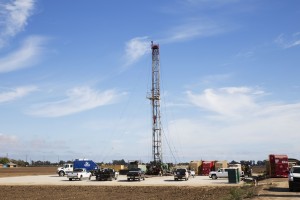
A fracking site sits next to two deep injection wells owned by Anterra, a wastewater injection company, in Oxnard, California. CREDIT: Sarah Craig/Faces of Fracking (flickr)
Are hydraulic fracturing (fracking) residual wastes, now being “legally” disposed of in many of the nation’s sewage treatment facilities, posing unknown threats to the food chain, and thus human health and the ecosystem, as “biosolids” (a by-product of sewage sludge disposal) are routinely dispersed onto arable land with little or no oversight by the regulatory authorities?
This is the basic research question being explored by a new course offered for the first time by the Sustainability Studies Program this Fall. Entitled “Risk Assessment and Sustainable Development” (EDP 305), it will meet Tuesdays and Thursdays, 10:00 AM to 11:20 AM.
As the instructor for this course, I am no stranger to risk assessment. During my seven years with Barry Commoner’s Center for the Biology of Natural Systems at Queens College, I was party to numerous critical evaluations of environmental impact statements (“EIS”). There was among my colleagues a very hard-headed view about these documents. One could observe what too frequently amounted to boiler plate narratives that built off of inaccurate data, shaky methodologies and questionable assumptions to generate startlingly precise numerical representations of estimated human mortality that somehow never exceeded the one in a million threshold over the average human lifetime. To us, it truly appeared that the high-priced consultancy firms employed by corporate developers of trash incinerators or hazardous waste disposal companies had started with their numerical target and simply worked their way back through the equations pre-selecting data that would support the desirable outcome.
This admittedly jaded view of risk assessment informs my direction of instruction but does not define it. Lacking any other truly viable technique for determining the consequences of new technologies and developments that intrude on the ecosystem, we have come to accept the EIS as a standard measure. Thus, we should be vigilant in how they are used, or misused.
We will examine the Final Supplemental Generic Environmental Impact Statement issued by the New York State Department of Environmental Conservation on High-Volume Hydraulic Fracturing in NYS (you can learn about it here). We will also examine the US EPA health risk assessment on land application of biosolids in addition to some of the critical analyses by selected researchers of their methodology (see for example the EPA’s biosolids fact-sheet and “A Critical Review of the U.S. EPA’s Risk Assessment for the Land Application of Sewage Sludge” by Jennifer M.J. Mathney).
The take-away from this course will be a framework that each student will have developed for appreciating both the potential and the limitations of risk assessment. These are common instruments used in the regulatory process that can both inform and confuse the public. Data can be easily cherry-picked to support pre-determined outcomes, or critically analyzed to illuminate flawed assumptions and weak methodologies. My intention is to demystify what can be a bewildering process.
Those of us who strive to achieve “sustainability” are constantly pitted against those whose ideas of sustainability may be entirely contrary to ours and we end up battling with weapons of data. Whose data are accurate? Whose data are to be believed? The answers to these questions are not often clear-cut. Sometimes though, they are unmistakable.
 By H. James Quigley, Jr., Ph.D.
By H. James Quigley, Jr., Ph.D.


